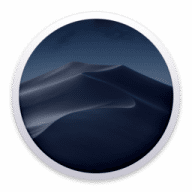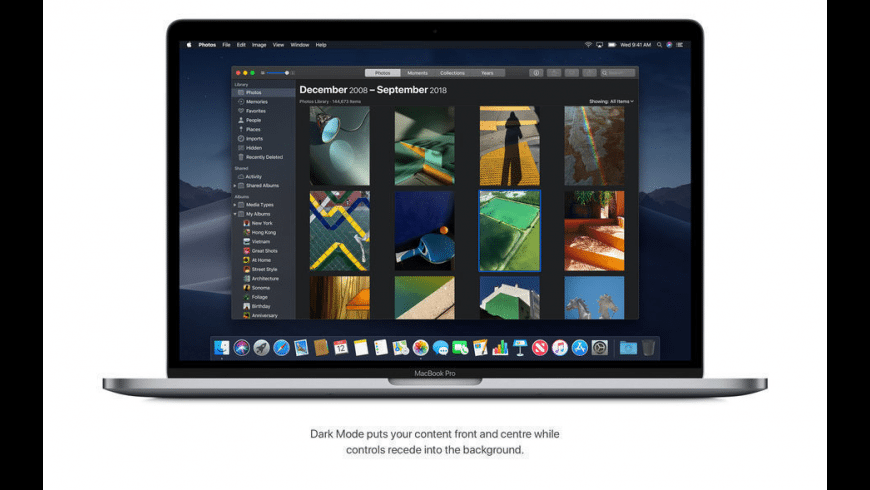Free
One-Time Purchase
macOS Mojave overview
macOS Mojave delivers new features inspired by its most powerful users but designed for everyone. Stay focused on your work using Dark Mode. Organize your desktop using Stacks. Experience three new built-in apps. And discover new apps in the reimagined Mac App Store.
Dark Mode
- Experience a dramatic new look for your Mac that puts your content front and centre while controls recede into the background.
- Enjoy new app designs that are easier on your eyes in dark environments.
Desktop
- View an ever-changing desktop picture with Dynamic Desktop.
- Automatically organize your desktop files by kind, date or tag using Stacks.
- Capture stills and video of your screen using the new Screenshot utility.
Finder
- Find your files visually using large previews in Gallery View.
- See full metadata for all file types in the Preview pane.
- Rotate an image, create a PDF and more - right in the Finder using Quick Actions.
- Mark up and sign PDFs, crop images, and trim audio and video files using Quick Look.
Continuity Camera
- Photograph an object or scan a document nearby using your iPhone, and it automatically appears on your Mac.
Mac App Store
- Browse handpicked apps in the new Discover, Create, Work and Play tabs.
- Discover the perfect app and make the most of those you have with stories, curated collections and videos.
iTunes
- Search with lyrics to find a song using a few of the words you remember.
- Start a personalized station of any artist’s music from the enhanced artist pages.
- Enjoy the new Friends Mix, a playlist of songs your friends are listening to.
Safari
- Block Share and Like buttons, comment widgets and embedded content from tracking you without your permission with enhanced Intelligent Tracking Prevention.
- Prevent websites from tracking your Mac using a simplified system profile that makes you more anonymous online.
Stocks
- Create a customized watchlist and view interactive charts that sync across your Mac and iOS devices.
Voice Memos
- Make audio recordings, listen to them as you work with other apps, or use them in a podcast, song or video.
- Access audio clips from your iPhone on your Mac using iCloud.
Home
- Organize and control all of your HomeKit accessories from your desktop.
- Receive real-time notifications from your home devices while you work.
What’s new in version 10.14.6
Updated on Jul 24 2019
Version 10.14.6:
Note: Mojave Security Update 2020-002 (70.5 MB)
- Addresses an issue which prevents creation of a new Boot Camp partition on iMac and Mac mini with Fusion Drive
- Resolves an issue that may cause a hang during a restart
- Resolves a graphics issue that may occur when waking from sleep
- Fixes an issue that may cause fullscreen video to appear black on Mac mini
- Improves file sharing reliability over SMB
Information
License
Free
Size
6.42 GB
Downloads
65667
App requirements
- Intel 64
- Intel 32
- OS X 10.8 or later
- Minimum 2GB of RAM
- Intel HD and Iris Graphics 4000 series or newer, AMD GCN-based GPUs, or Nvidia Kepler-based GPUs or newer
- Required free space:
- At least 12.5 GB of available disk space to upgrade from OS X El Capitan, macOS Sierra, or macOS High Sierra
- At least 18.5 GB of available disk space to upgrade from OS X Yosemite and earlier
Try our new feature and write a detailed review about macOS Mojave. All reviews will be posted soon.
(0 Reviews of )
There are no reviews yet
Comments
User Ratings
Feb 8 2021
Version: 10.14.6
fucking OS update macOS Mojave its not updated properly. After effects Animation software is not opening. Am contact apple support service but they also not no how to fix this problem. Kindly never update to macOS Mojave.
Nov 29 2020
Version: 10.14.6
wish I had never upgraded to mojave. the most recent Sept Oct Nov 2020 updates have royally screwed up what was already laggy, freezing, stalling, sluggish most awful OS X ever. If you haven't upgraded to Mojave, I recommend. you do NOT.
Sep 11 2020
Version: 10.14.6
The link takes you to a Google Drive for the download.
I'm guessing this isn't Apple's official location for downloading older versions of macOS.
May 27 2020
Version: 10.14.6
Security Update macOS Majove 2020-03
https://updates.cdn-apple.com/2020/macos/061-90106-20200520-c30a1761-e8a5-4b86-af96-a09d892cac97/SecUpd2020-003Mojave.dmg
Oct 5 2019
Version: 10.14.6
This message appears:
Oops, sorry we don't have the DMG file :(
You can leave MacUpdate, and be redirected to apps.apple.com, to download this app
Sep 26 2019
Version: 10.14.6
I guess MacUpdate is too busy to do what they do? There's been TWO Updates since this last one.
Aug 30 2019
Version: 10.14.6
NOTE, Apple released TWO different 10.14.6 Supplemental Updates, one on Aug 1, and another on Aug 26, 2019. To confuse matters, both share the exact same name, and the download link is the same (basically they slipped streamed the second update in). Update #1 will update your system to Build 18G87, update #2 to Build 18G95.
If you're wondering why your Mac is prompting you again to install the Supplemental update, this is why. If you installed the Supplemental PRIOR to Aug 26, but aren't getting prompted to install again (i.e. #2), you may want to get #2 and install anyways, as it sounds like there was a bug regression or incomplete fix in the #1.
https://support.apple.com/kb/DL2015?locale=en_US&viewlocale=en_US
Aug 4 2019
Version: 10.14.6
I was putting off upgrading from High Sierra, which was working nicely with everything on my late 2013 iMac - now I regret updating to Mojave. Simply awful - bug-ridden, slow ui, tempramental with Wacom tablet & external usb enclosure, to name a few issues. If you are running High Sierra with little to no issues, stick with it - Mojave is a kludge.
Jul 31 2019
Version: 10.14.6
Can anyone provide a direct link to Mojave 10.14.6? I'm sick and tired of trying to download it from the Mac App Store. I need the full installer. On one machine, it downloads a full installer, but it's Mojave 10.4.5 instead of the most current version. WTF? On another machine, it downloads a ~23 MB installer instead of the full installer. Geez. It feels like I have crossed over into the Windows camp. Way to go, Apple.
Jul 31 2019
Version: 10.14.6
Completely screws vlc menus - colour artefacting & distortion make it impossible while any kind of video is open.
Jul 27 2019
Version: 10.14.6
!! NOTE !! -- due to a bug with 'wake from sleep' issues on many different models of Mac products, Apple PULLED the High Sierra and Sierra security updates from July 22, 2019 from their Apple Support Downloads page and Software Update.
Jul 25 2019
Version: 10.14.6
My ProMacBook Pro (Retina, 15-inch, Mid 2015) serial No: C02Q96BNG8WN Graphic Intel:Intel Iris Pro 1536 MB MAC OS 10.14 Does not have the inbuilt sound device.
Should any one email me a free httpp; id address so I can intall. NO input and out put device on my sound device. please email me: sidneyolene@gmail.com.
Jul 23 2019
Version: 10.14.6
No problem at all and very short updatetime - iMac mini 2018 i/ and 28'' Monitor. A big thanks to Apple!
Mar 28 2019
Version: 10.14.4
Broke the display on a new 2018 Mac Mini 6 core i7 running hdmi to dvi. Now only black screen. Funny that Mac Mini compatibility fix for 2018 was specifically mentioned in the update...maybe they meant by eliminating support?
Mar 26 2019
Version: 10.14.4
Apple issued Security Updates 2019-002 10.13.6 High Sierra, and also Security Update 2019-002 10.12.6 Sierra - They have put the Sierra update on Apple's Support Download page, but the one for High Sierra says it has a creation date of Dec.8 2018!!!
Direct download links for both would be much appreciated.
Mar 26 2019
Version: 10.14.4
Does anyone have the link to download the 10.14.4 version of macOS Mojave ?
Mar 26 2019
Version: 10.14.4
Updated with no problems. Quickest update I have ever installed. Ran disk utility after update, no problems.
Mar 14 2019
Version: 10.14.3
After running Mojave 10.14.3.3 on three UNSUPPORTED Macs for a month ( 09 Mini, 08 Aluminum Macbook, and mid-10 iMac) this by far the best macOS release since Snow Leopard. http://dosdude1.com/mojave/
Free
One-Time Purchase
Similar apps
GPG Suite
OpenPGP on macOS.
Is this app is similar to GPG Suite? Vote to improve the quality of this list.
Vote results
2
Upvotes
2
Total score
0
Downvotes
OS X Mountain Lion
The final update for OS X 10.8.
Is this app is similar to OS X Mountain Lion? Vote to improve the quality of this list.
Vote results
0
Upvotes
1
Total score
0
Downvotes
OS X Yosemite Security Updates
Security Updates for OS X Yosemite.
Is this app is similar to OS X Yosemite Security Updates? Vote to improve the quality of this list.
Vote results
0
Upvotes
1
Total score
0
Downvotes
macOS High Sierra Security Updates
The latest Security Updates for macOS High Sierra.
Is this app is similar to macOS High Sierra Security Updates? Vote to improve the quality of this list.
Vote results
1
Upvotes
0
Total score
-1
Downvotes
sweetmail namera
Internet email client.
Is this app is similar to sweetmail namera? Vote to improve the quality of this list.
Vote results
0
Upvotes
-1
Total score
-1
Downvotes
New and Recently Updated




































